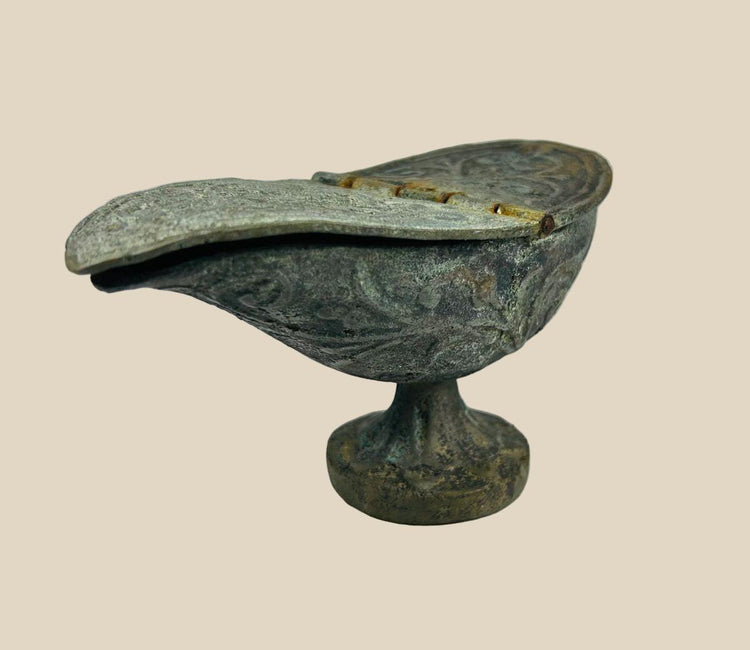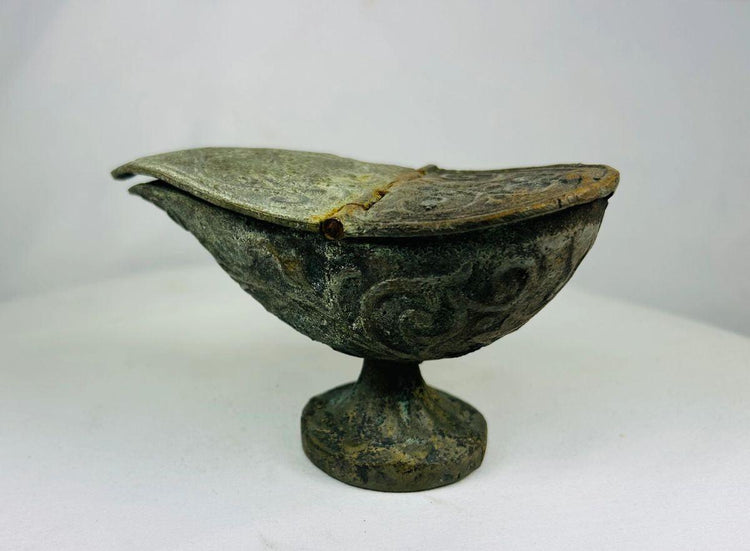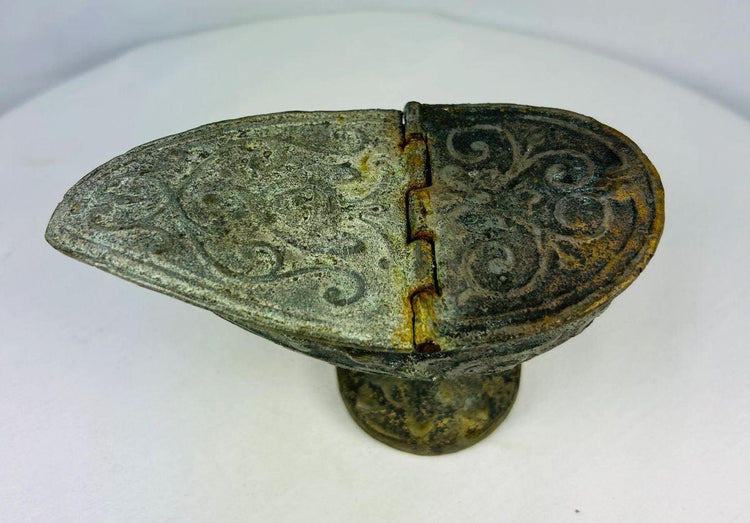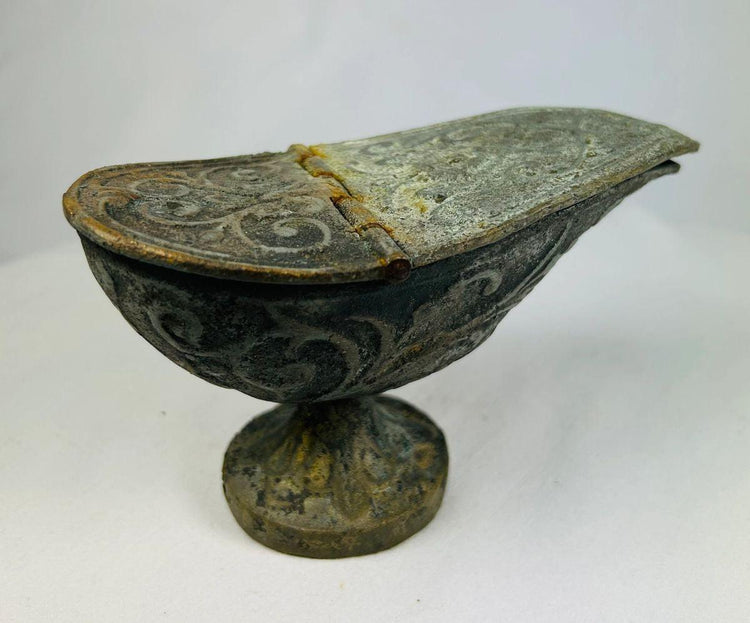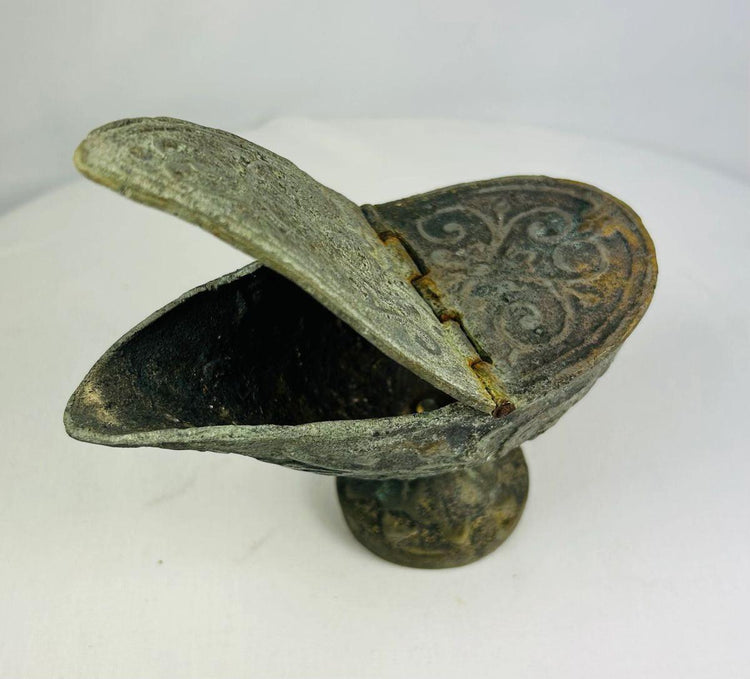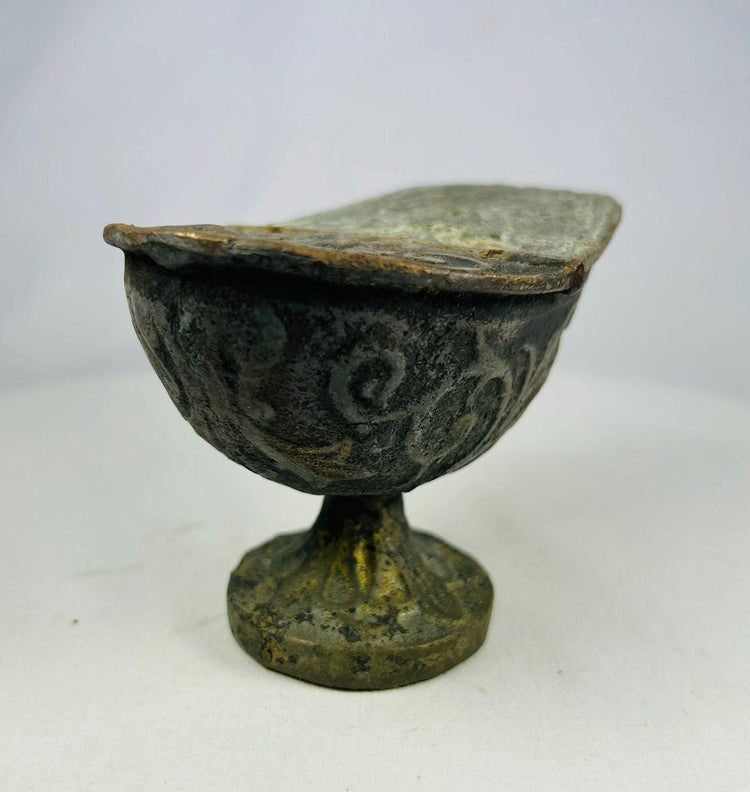Ancient Chinese | Bronze Oil Lamp | Han Dynasty | Circa 206 BCE – 220 CE
Description
More
Less
Historical Context & Origin
Region: Ancient China
Material: Cast bronze with engraved decoration
Period: Han Dynasty (206 BCE – 220 CE)
Description
This beautifully crafted bronze oil lamp is a fine example of Han Dynasty metalwork, reflecting both functional utility and aesthetic refinement. Cast in bronze and richly adorned with engraved swirling motifs, the lamp would have served as an important household or ritual object in ancient China. Its elongated spout was designed to hold a wick, while the hinged lid allowed the user to control airflow, protect the oil from debris, and safely extinguish the flame. A flared pedestal base ensured stability, making it suitable for use in homes, temples, or official residences. Bronze lamps such as this were often owned by the wealthy or officials, while clay versions were more common among ordinary households. Similar pieces have been discovered in tombs, underscoring their importance in both daily life and the afterlife.
Features
- Hinged lid for airflow control and extinguishing the flame
- Elongated curved spout designed to hold a wick
- Flared pedestal base for stability on tables or altars
- Intricate engraved swirling patterns with symbolic motifs
- Rich, aged patina from centuries of burial and oxidation
Cultural Significance
During the Han Dynasty, oil lamps were indispensable in households, workshops, and temples, providing light long before the use of candles became widespread. Bronze examples such as this also carried status, reflecting wealth and refinement. Their presence in tombs indicates that they were not only functional in life but also symbolically important in the afterlife, ensuring eternal illumination and divine protection.
Condition
The lamp survives in excellent archaeological condition, with a well-preserved green patina testifying to its age. The hinge remains intact, and the vessel retains its full form with no major losses. Minor surface corrosion is present, consistent with long-term burial, but overall stability and craftsmanship remain clearly visible, enhancing its authenticity and value.
Dimensions (approximate)
Length: 5.5 in
Width: 3 in
Height: 3 in
Age
Over 1,800 years old
Learn More
Deepen your understanding of early Chinese lighting technology, bronze craftsmanship, and the evolution of oil lamps in antiquity: Folding Oil Lamp – Han Dynasty Example (Art Institute of Chicago)
Explore more authentic artifacts from ancient China, including imperial relics, ritual bronzes, tomb furnishings, and early household objects: Ancient Chinese Artifacts & Imperial Relics – Relic And Rarity
Description
Historical Context & Origin
Region: Ancient China
Material: Cast bronze with engraved decoration
Period: Han Dynasty (206 BCE – 220 CE)
Description
This beautifully crafted bronze oil lamp is a fine example of Han Dynasty metalwork, reflecting both functional utility and aesthetic refinement. Cast in bronze and richly adorned with engraved swirling motifs, the lamp would have served as an important household or ritual object in ancient China. Its elongated spout was designed to hold a wick, while the hinged lid allowed the user to control airflow, protect the oil from debris, and safely extinguish the flame. A flared pedestal base ensured stability, making it suitable for use in homes, temples, or official residences. Bronze lamps such as this were often owned by the wealthy or officials, while clay versions were more common among ordinary households. Similar pieces have been discovered in tombs, underscoring their importance in both daily life and the afterlife.
Features
- Hinged lid for airflow control and extinguishing the flame
- Elongated curved spout designed to hold a wick
- Flared pedestal base for stability on tables or altars
- Intricate engraved swirling patterns with symbolic motifs
- Rich, aged patina from centuries of burial and oxidation
Cultural Significance
During the Han Dynasty, oil lamps were indispensable in households, workshops, and temples, providing light long before the use of candles became widespread. Bronze examples such as this also carried status, reflecting wealth and refinement. Their presence in tombs indicates that they were not only functional in life but also symbolically important in the afterlife, ensuring eternal illumination and divine protection.
Condition
The lamp survives in excellent archaeological condition, with a well-preserved green patina testifying to its age. The hinge remains intact, and the vessel retains its full form with no major losses. Minor surface corrosion is present, consistent with long-term burial, but overall stability and craftsmanship remain clearly visible, enhancing its authenticity and value.
Dimensions (approximate)
Length: 5.5 in
Width: 3 in
Height: 3 in
Age
Over 1,800 years old
Learn More
Deepen your understanding of early Chinese lighting technology, bronze craftsmanship, and the evolution of oil lamps in antiquity: Folding Oil Lamp – Han Dynasty Example (Art Institute of Chicago)
Explore more authentic artifacts from ancient China, including imperial relics, ritual bronzes, tomb furnishings, and early household objects: Ancient Chinese Artifacts & Imperial Relics – Relic And Rarity
You May Also Like






















